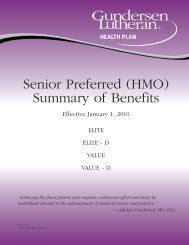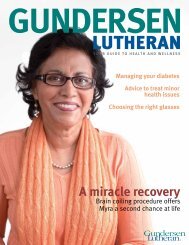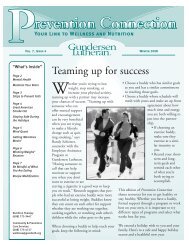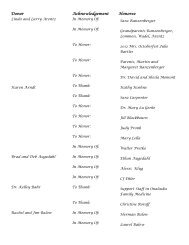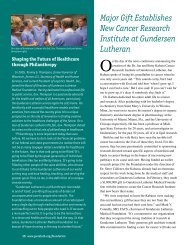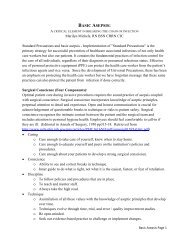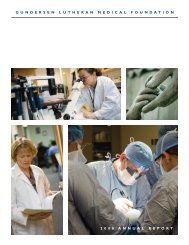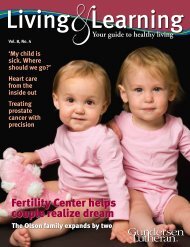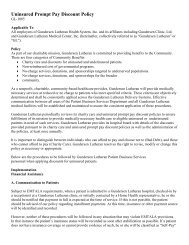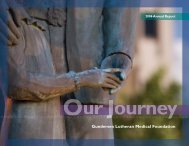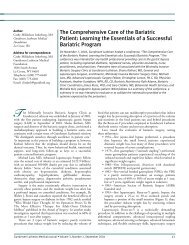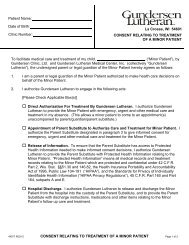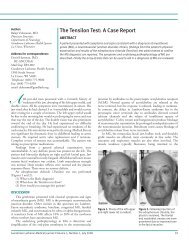Streptococcus bovis - Gundersen Lutheran Health System
Streptococcus bovis - Gundersen Lutheran Health System
Streptococcus bovis - Gundersen Lutheran Health System
Create successful ePaper yourself
Turn your PDF publications into a flip-book with our unique Google optimized e-Paper software.
the hiStory of CArdiAC rehAbiLitAtion At the uniVerSity of WiSConSin–LA CroSSSe<br />
would visit a number of existing cardiac rehabilitation programs<br />
around the country. The pair traveled to and observed programs<br />
at San Diego State College, the University of San Francisco, the<br />
University of Wisconsin–Madison, and the Cleveland Jewish<br />
Community Center. Shortly after the visits, the task force<br />
drafted a policies and procedures document for the LEHP. In the<br />
spring of 1971, an LEHP executive board was created and held<br />
its first meeting. The board consisted of Drs Robert Batchelder,<br />
Donovan Riley, and Philip Wilson (UW–L); Drs Allen Brailey,<br />
Robert Green, Robert McMahon, and Edward Winga (<strong>Gundersen</strong><br />
Clinic); Dr Charles Link (Skemp Clinic); and Cal Jahn (consumer<br />
representative). The executive board was responsible for developing<br />
and monitoring the policies and procedures of the LEHP.<br />
Even though the LEHP was incorporated as an operational body<br />
of UW–L, the creation of the program truly was a collaborative<br />
effort between the University, the Wisconsin Heart Association,<br />
the La Crosse County Medical Society, and La Crosse <strong>Lutheran</strong><br />
and St. Francis hospitals. The initial cost of LEHP was shared<br />
across institutions, and it was agreed that the program would be<br />
offered for a 1-year pilot period and then evaluated for possible<br />
continuance.<br />
On June 6, 1971, the first exercise session of the newly created<br />
LEHP was offered. Six cardiac rehabilitation patients completed<br />
an exercise class under the supervision of exercise physiologists and<br />
physicians. Program personnel made a strong effort to promote<br />
and market the LEHP, and after the first year the enrollment had<br />
grown from 6 to 31 participants. Area physicians appeared to be<br />
supportive of the program as well, with 14 physicians volunteering<br />
to help supervise LEHP activities.<br />
Over the next few years the program continued to grow in<br />
enrollment, and new policies and procedures were developed.<br />
Program personnel sought grants from the Grandview Foundation,<br />
the National Institutes of <strong>Health</strong>, the Wisconsin Heart Association,<br />
and the United Fund to help offset program costs, and a new cardiac<br />
rehabilitation internship program was created. It was decided<br />
that all cardiac rehabilitation participants would receive a graded<br />
exercise stress test prior to admittance into the program, and again<br />
after 3 and 6 months of participation. It was also decided that<br />
LEHP participants would be divided into cardiac-prone (1 or more<br />
cardiovascular risk factors) and advanced cardiac (known disease)<br />
groups and would exercise on different days of the week.<br />
In 1974, the American College of Cardiology selected UW-L<br />
(with support from <strong>Gundersen</strong> Clinic) as a training center for<br />
physicians interested in cardiac rehabilitation and exercise testing.<br />
It was also about this time that the LEHP sponsored a cardiac<br />
exercise technician workshop. Since the early 1970s, the LEHP has<br />
sponsored and conducted hundreds of educational programs on<br />
topics including cardiac rehabilitation, electrocardiogram (ECG)<br />
interpretation, weight management, industrial fitness, pulmonary<br />
rehabilitation, and exercise testing. One of the more successful<br />
workshops, a sports sciences symposium, was offered in 1984 and<br />
brought more than 600 medical personnel from the United States<br />
and around the world to La Crosse. It is estimated that over the<br />
past 35 years, over 10 000 participants, from all 50 states and 43<br />
countries, have attended LEHP workshops and symposia.<br />
In the fall of 1975 the LEHP began publishing Cardio-Gram,<br />
a bi-monthly newspaper that contained articles of interest to both<br />
LEHP participants and medical personnel working in the field of<br />
cardiac rehabilitation. Over the next few years the paper became<br />
more popular and grew to a circulation of over 3500 subscribers.<br />
In the early 1980s, LEHP staff secured a sponsorship for Cardio-<br />
Gram through Pfizer Laboratories (New York), which resulted in the<br />
paper being circulated to roughly 25 000 healthcare professionals.<br />
The paper was eventually replaced by a program newsletter. The<br />
Sun Rise Express, The Beat Goes On, and The Pacesetter are all titles<br />
the newsletter has had over the past 25 years. The program still<br />
publishes a popular monthly newsletter, The La Crosse Exercise and<br />
<strong>Health</strong> Program Newsletter.<br />
The mid 1970s was also a time when LEHP staff began<br />
offering educational programming to participants. Topics<br />
included nutrition, benefits of exercise, behavior modification,<br />
and risk factors for cardiovascular disease. Offering educational<br />
opportunities to both participants and community members<br />
has been a hallmark of the program for the past 30 years. Some<br />
current examples include 10-minute tidbits—short educational<br />
programs presented to participants every 2 weeks—and the LEHP<br />
<strong>Health</strong> Lecture Series, a new series of talks that will be offered<br />
every February to help recognize the American Heart Association’s<br />
Heart <strong>Health</strong> Month.<br />
Throughout the early and mid 1970s, the LEHP offered exercise<br />
programming for individuals in need of cardiac rehabilitation.<br />
However, in January of 1977, the program expanded services to<br />
nonclinical populations and created an adult fitness unit. The<br />
adult fitness unit was to serve apparently healthy individuals with<br />
the goal of helping participants prevent disease and maintain or<br />
increase fitness levels. Also in 1977, the Board of Regents of the<br />
University of Wisconsin <strong>System</strong> approved a master’s degree in<br />
Adult Fitness and Cardiac Rehabilitation at UW–L. This was an<br />
exciting time for the university because this was the first program<br />
of its kind in the country, and because until this program was<br />
approved, the only UW system school that offered medically<br />
related degree programs was UW–Madison. A number of other<br />
colleges and universities adopted the university-based cardiac<br />
rehabilitation model created at UW–L. In 2004, the Adult Fitness<br />
and Cardiac Rehabilitation Program was renamed and is now<br />
the Clinical Exercise Physiology program. In the past 30 years,<br />
roughly 500 students have graduated from this program and are<br />
employed in cardiac and pulmonary rehabilitation programs in<br />
nearly every state in the country, as well as a number of countries<br />
around the world.<br />
Over the years, LEHP staff has employed a variety of incentivebased<br />
initiatives to help motivate participants. One of the first,<br />
implemented in 1977, was a program in which participants who<br />
attended 3 exercise sessions a week for 6 months were rewarded<br />
with a t-shirt. The LEHP still uses a variety of incentive programs<br />
to help motivate participants to achieve their health- and fitnessrelated<br />
goals. Longtime LEHP member Don Kirby recently posed<br />
for a photograph wearing a 1000 Mile Club shirt he received in the<br />
late 1970s (Figure 2).<br />
In the early to mid 1980s, the LEHP continued to expand the<br />
services offered to the community. A collaborative diabetic services<br />
program was created and implemented with cooperation from<br />
the <strong>Gundersen</strong> and Skemp-Grandview clinics. The program also<br />
began offering services related to pulmonary rehabilitation and<br />
<strong>Gundersen</strong> <strong>Lutheran</strong> Medical Journal • Volume 6, Number 1, June 2009 31




